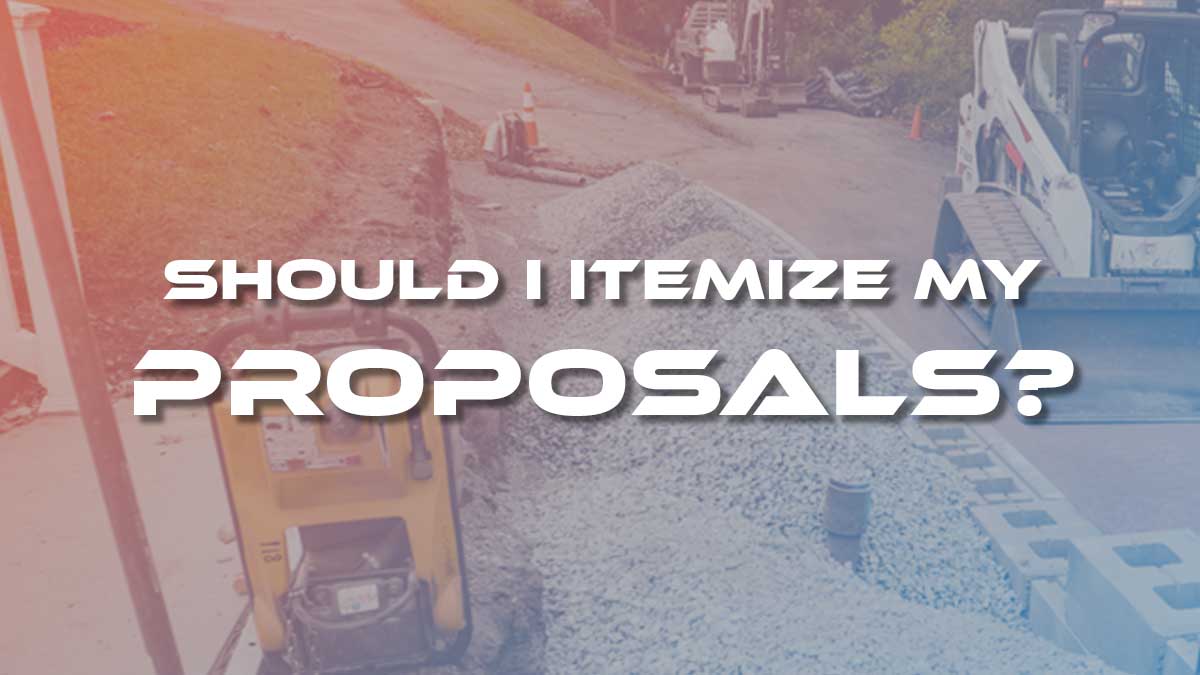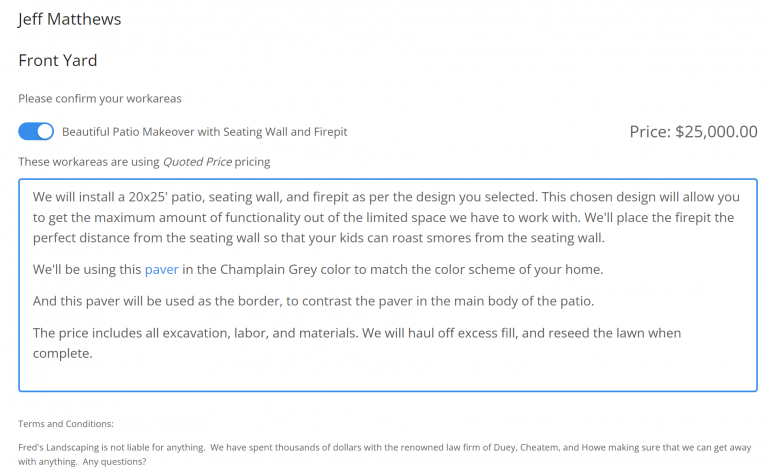Man! This one will pull opinions in a Facebook thread in a contractor group! People that usually stay hidden in the background come out of the woodwork to share their facts – I mean opinions – on the best practices and what details to include in proposals for your prospects.

The point of this article is to explore the pros and cons of itemizing vs not itemizing your proposals, draw your attention to some things that you may not have considered, and let you decide what you are most comfortable with and what you want to do. You may change your mind and start doing it a different way, or you may not. The point of the article is not to change your mind. (although it probably won’t be hard to see which way I lean 😜) Seriously though, my goal is to help you make a balanced decision that you are most comfortable with.
A lot of it really does come down to personal style and preference. What I say here needs to be taken with a grain of salt, as we all have our personalities and may be more natural or better with one method vs another. Your customer’s personality plays into this as well.
Here’s the 2 methods:
1. Itemize and break all materials and labor down on each line item
2. Show line items with description and lump sum price only, no itemized materials & labor
Method 1: Itemize and Break Everything Down:
The general idea here is to show everything on the line item. Each nut, bolt, and screw. How many labor hours. What the materials costs. What the labor costs. The scientific name of that product you’re using along with the part number.

Pros and Cons of Itemizing Proposals:
Pros:
- Transparency – Customer sees what all really goes into providing the service
- Justification – Customer can see why it costs so much, and where the costs are
- Connection to where the costs are. (If customer wants an upgrade, they’ll need to add items, aka more costs. If customer wants to save money, they need to pick something on the list to remove.)
I believe that one driving factor that makes contractors use this method is to show a spirit of transparency. I have also seen contractors use this method as a way of justifying the high price of the service they are quoting. There’s something about throwing a laundry list of materials (many of which the customer will have no idea what they are for) that makes the contractor feel better about the price. Just maybe if I make this list long enough, the customer will see why the price is so high. They’ll feel like they’re getting more.
Another reason might be to prove your skill and experience. Your extensive knowledge is seemingly made obvious in the long list of technical items on the quote. A lesser experienced contractor wouldn’t be able to provide such a complicated list of what is going into the service you are providing.
Regarding the “connection to where the costs are” factor – the idea is it forces the customer to choose: If customer wants an upgrade, they’ll need to add items, aka more costs. If customer wants to save money, they need to pick something on the list to remove. The problem is, they aren’t the expert than can make that choice. You are. That’s why they called you. I believe you shouldn’t make them choose parts to eliminate. You should provide the choices they can make for them. Make it easy for them.
Cons:
- Selling parts list and widgets instead of the finished result, or the outcome/benefit
- Tends to drag out the proposal approval process
- Analysis paralysis customers objecting, asking questions on things they know nothing about
- Customer objecting to final invoice when they see certain items not being used or took less time than quoted
All the points above can all really be rolled into the first one: selling a parts list instead of the outcome/benefit. For example: if you build beautiful outdoor living spaces, and you detail out the stone base, the edge restraint for the patio, the separation fabric on your quote – you’ve suddenly pulled their focus from the beautiful evenings they were anticipating spending outdoors with family, to the technical aspects that they likely have never heard of and have no knowledge of. And now because they’ve suddenly had their attention drawn to it for the first time ever, they have a million questions!
Uncertainty, doubt, and objections start to pop up. Do we really need that item? I see it’s adding a fair amount to the cost. I googled that item and I found it for much cheaper over here, why is yours so expensive? Can I just buy the materials myself? Is it really going to take that many labor hours? Your labor rate is what!??
…and there you go. You spiral down into a long series of back and forth communication. Before you know it, the focus is completely off of the emotion, excitement, and visions of the beautiful outcome you were going to create for them that made them call you in the first place.
It’s replaced with anxiety. They are overwhelmed. Are they making the right decision? Do you really know what you’re doing? How can they be sure you aren’t missing some other technical item?
They’ve lost their fervor for the project.
And you’re left trying to justify your methods and technical approach.
Yes, I really do need that item. No you can’t buy the materials, I need control of the whole process to provide what you are asking for in a timely and efficient manner. That item you googled isn’t even the same item. Yes it really will take that many hours. Yes running a business is expensive, my labor rate is what it is. Didn’t you call me to build a beautiful outdoor living space where you are going to make priceless memories with loved ones? Can’t we talk about the design, what you want out of the finished product, and what’s important to you functionally? Like I noticed you have a bird feeder, is that a hobby of yours? We could add a fountain to the design, birds love them!
The final point I listed above about customers raising objections on the final invoice because they saw you took extra materials back etc reminds me of a story. We were building a pondless waterfall for a customer, and this customer was definitely one of those analysis paralysis folks. We had brought more rock than we had quoted on the estimate, just so we had a better picking choice of rock on site while building the waterfall. When we were finished and were loading up the extra to take back to the shop, the customer came running out and said “Hey! I paid for those rocks I want to keep them.” I’ll never forget what Derek, the salesperson who sold the job did next. Derek straightened up from loading the rock and turned to face him. “No, we bought those rocks. You bought that” and pointed to the newly installed waterfall.
“Well then I want a refund for the extra rock.”
“You didn’t buy this rock, we did”
I remember thinking, “Wow! That was good.” And it was. The customer just paused, seemed to see the sense in Derek’s explanation, shrugged his shoulders, nodded, and accepted it.
Method 2: Not Itemizing ProposalsThe concept here is to sell what the customer asked for. Providing a price and a description of the outcome/benefit that the customer will be receiving instead of a parts list.
Pros and Cons of Not Itemizing Proposals
Pros:
- Keeps the focus where it should be – on the outcome/benefit of the job
- Doesn’t overwhelm the customer with details they have no expertise in. You are the expert, that’s why they called you
- Simplifies and shortens the proposal approval process
- No justification of your items and costs needed.
Using my analogy again – the customer called you and wanted to build their dream outdoor living space! Now, I have a question for you: are you selling a parts list and widgets? Or are you selling a lifestyle?
Lets imagine the customer mentioned a sibling was moving back into the area and they want a space where their kids can spend time together. Don’t overwhelm them with technical details that only make sense to you – the expert. Sell them what they asked for!
In the line item description, talk about how the well thought out design is going to help them maximize the function of their limited space. Because of this they’ll get more bang for their buck out of the space. They have young kids, and kids love smores, so you incorporated a fireplace. They mentioned they love the sound of water, so you designed the space with a rippling brook. Plus they want their kids to unplug, and nothing draws kids outdoors like playing in water.
Sure, include details like how large the patio will be, and that the color of the pavers was chosen to compliment the color scheme of their home. But don’t trigger needless questions by including technical details and parts lists. Your competency is much better backed by a solid guarantee, your online reviews, your referrals, and your beautiful portfolio of past work.
And one side note on the labor rate. It’s a funny thing, but I’ve seen it multiple times, so I can’t ignore it. If you show your customer that your hourly rate is $95/hr, it raises eyebrows and some will object and question. I even had one customer that straight up didn’t do the job because of the $ amount per hour. Prior to that moment, he had seen the total price of the job, and had no objection and we were talking about scheduling the job. Then when he saw the labor rate I had written on the proposal, he switched from being ok with the price to totally not ok with the price.
It’s as if they see the total job price is $20k, it’s like “Oh, ok, that’s something I can swing. Then when they see the price per hour, they have a preconceived idea on what they think labor should be worth, and balk. Weird.
Cons:
- Customer can’t see where the costs are, so if they need to cut budget, they need to ask you how to do that (is that even a con?) instead of looking for the largest $ ticket items in the breakdown and questioning whether you really need that or asking what they could remove.
- For some customers that have a technical/engineering style personality, they may feel the need to see the technical details and can’t.
- Maybe I have confirmation bias, but I’m drying up. I can’t think of any more.
Thinking about this as I write this, I’m reminded again how much your view of the different methods would change based on your own personality as a salesperson. For myself, I would WANT my customer to ask ME how and where they can cut budget. As opposed to scrutinizing my detailed itemized proposal. They are trusting me as the expert. It’s my duty to perform as the expert and help them find the solution that fits their budget. And not unnecessarily overwhelm them with white noise and details they have no way of knowing what it means.
But I also have friends that feel the opposite way. They feel that by showing the customer the completely itemized list, they are being transparent, and can use it as reinforcement to justify why the price is what it is. “I can’t remove that expensive item, I need it for so and so to do the job properly…” and so on.
But the way my mind processes that is I’m inviting the customer to debate me on the items within the quote, as opposed to me guiding them on what choices they could make to get the budget where they want it.
I should clarify, when I speak of itemizing, I am referring to quotes that literally have every single bolt, screw, and item displayed for the customer. I don’t mean taking a large project and only providing a description of the entire project and one price. I would take the entire project, show it in separate line items, broken out by how I want the customer to choose between the options. This allows me to offer good, better, best options, or even optional addons, all as separate line items. But within each of those line items, I’d have a description highlighting the what the finished product will look like, any guarantees we provide, and the benefit/outcome I believe the customer is looking for.
For example:
Full Outdoor Living Space Project:
Line item 1: 20×25 Patio (w/ description and price)
Line item 2: Seating wall and firepit (w/ description and price)
Line item 3: Optional Landscape Lighting addon (w/ description and price)
Line Item 4: Water Fountain (w/ description and price)
and so on.
This will easily and plainly communicate the choices the customer could make that would have an impact on the budget. And is keeping the focus on the final outcome, instead of the parts list and labor inside each of those line items that I worked up to find the price.
To summarize…
It really does come down to personal style. Some people can navigate the conversation around justifying their parts list and labor price better than I can, and don’t mind the cons I listed at all. They actually feel it helps them earn trust. Others are more like me, and want to avoid that technical and detail oriented conversation, and find it easier to perform the art of the sale while discussing the various line item options with the client.
Help me learn some new ways to spin this subject. What do you find works best for you? Anything you have to add or contradict? Let me know in the comments!









